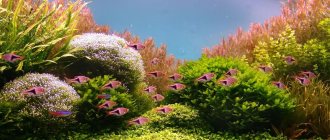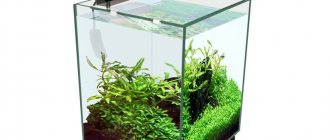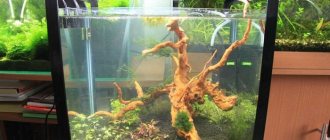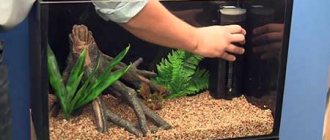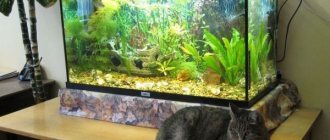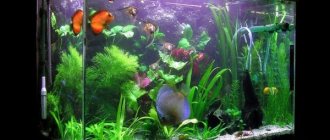Home/DIY HANDS/Do-it-yourself aquarium for fry in a community aquarium
A fish tank for fry in a community aquarium is designed to preserve young animals and fry. After all, many phenotypes consume them as food. If the young animals are not isolated, they will die.
Types of depositors
Traditionally, fish tanks begin to be used before spawning. The pair are separated for this period and returned to the common aquarium after spawning. The fry remain in the hatchery until they grow up. Beginning aquarists like to use glass jars and other containers as separate aquariums for young animals. This is not always convenient. Moreover, if there are several phenotypes in the aquarium, the number of jars can reach a huge number. This is not always convenient, especially when it comes to small spaces. It is much more convenient and cheaper to make a fish tank in a common aquarium. Here are the three most popular types of such nurseries:
- Reticulate.
- Transparent.
- Combined.
Each of these models has its own characteristics, advantages and disadvantages. Let's look at them in detail.
Maternity ward for fish
Arrangement
For fish that scatter eggs
For fish that stick eggs
For cichlids
For labyrinths
For carp-toothed
For fish that incubate their offspring in the mouth
Spawning methods
On the leaves
In a foam nest
On glass
Out of water
In a common aquarium
This type of spawning can be used when keeping one type of fish, peaceful in nature, like cardinals and palmeri. It is best to fence off a third of the container with a separator net, where Java moss and small-leaved plants are laid out at the bottom of most of it.
Spawning species
For viviparous
Mesh nurseries
Mesh models are budget types. For their manufacture, a rigid frame, polymer mesh, organic glass or similar materials are used. The structure is attached using hooks or specialized holders to the wall of the main aquarium. A mesh-type fish tank, despite its low cost, has 2 serious drawbacks:
- food debris and fish waste products accumulate in the cells;
- Sometimes adults penetrate into the nursery and cause damage to the fry.
This type of depositor is recommended to be used only when there are no other options.
Fish tank for viviparous fish
Breeding viviparous fish is a special art. Aquarists go to great lengths to protect offspring from their parents. Traditionally, shortly before giving birth, the female is placed in a separate aquarium. After the offspring are born, she returns to her usual habitat. But there are some problems with traditional types of fry aquariums. Minimal water circulation or stagnation often leads to the death of fish. For viviparous breeds, experienced aquarists recommend flow-through nurseries. They provide comfortable conditions for the life and development of young animals.
Do-it-yourself septic tank
Making a fish tank with your own hands is not difficult. To do this, you do not need to look for specialized tools or materials. The means at hand are quite sufficient. Let's consider making a combined model from scrap materials. For production you will need:
- plastic container (suitable for Korean carrots, seaweed, etc.);
- nylon tights;
- suckers;
- knife (preferably a stationery knife with a thin blade).
The container can be of any shape, but it is most convenient to work with a square one. Using a heated knife, cut holes in the container and lid. Please note that it is better to leave a border of about 1 cm at the bottom. This is done so that waste does not fall into the main aquarium and the manger is easy to clean. Then we pull the stocking over the body. Please note that stockings come in different densities and cell diameters. It is better to give preference to hosiery with small cells. Having put the nylon on the body, we remove everything unnecessary and secure the structure with a lid. For fixing to the wall of the aquarium, suction cups or hooks of the required length are used.
A flow-through depositor is a little more difficult to manufacture. It is glued together from organic glass. To prevent the fry from getting stuck in the cracks, insulating gaskets are installed. The nursery is connected to the main aquarium using a tube with a curved end. A cover made of nylon with large cells is placed on the bottom of the tube. It will prevent the fry from getting into the main aquarium and will solve the problem with water circulation. The bottom of the sedimentation tank is filled with fine-grained sand.
Separator mesh made from scrap materials
Many novice aquarists, in their search for literature on keeping and breeding their pets, have encountered, especially in old books, the expression “separator mesh.” Or just “grid”. Why is it needed and what is it even?
It's no secret that aquarium fish for the most part are predatory creatures. They will happily feast on any prey they can catch and swallow. “Everything that fits into your mouth is useful.” In a community aquarium, some (what are there, many!) species of fish spawn with great pleasure - the conditions here are selected specifically for them, everything is conducive to reproduction... Everything, except the presence of neighbors. Other fish happily eat the eggs laid by their unlucky parents. And the parents themselves are not averse to profiting from their own eggs: in nature, most species of fish spawn on the current, or in very large volumes - as a rule, having swept the eggs and fertilized them, the fish never see them again: the eggs are carried away by the current or they fall deep into the thickets aquatic plants. Those species that guard their eggs or lay them in close proximity to themselves are usually not dangerous to their fry and eggs. But there are relatively few such species.
Most egg-laying fish - almost all characins, almost all barbs, zebrafish and most other cyprinid fish that do not protect their eggs - are dangerous for them. In order to preserve the offspring from the neighbors in the aquarium, the breeding pair is removed from the common one into a separate small spawning aquarium(s), which usually contains the bare minimum of equipment and often does not even have plants. You don't have to worry about your neighbors. But the happy parents themselves are happy to use the opportunity to freely profit from a high-calorie dietary product. Therefore, they try in every possible way to protect the caviar from the fish themselves. To do this, the entire bottom of the aquarium is covered with Java moss, stems of cabomba, pinnate and other finely dissected plants. But this does not always work: just as there are fish that, having lost sight of the eggs, will abandon their unhealthy interest in them, there are also species that, in any case, will lurk in the thickets, methodically checking every twig until they leave nothing behind. Such malicious eaters of offspring, for example, include Nanostomus marginatus.
Therefore, aquarium breeders have long come up with a simple and effective way to preserve eggs, which also allows them to maintain cleanliness and a favorable oxygen regime in the spawning area: they separate adult fish from the eggs using a net. Since in English (and Latin) the verb “to separate” sounds like “separate,” the separator grid is usually called a separator grid. It is very convenient to use: it does not wear out, does not die, and does not consume oxygen at night, like mosses and other plants, and most importantly, when properly manufactured, it absolutely eliminates the contact of adult fish with laid eggs. In this material we will tell you how to quickly and inexpensively make such a separator mesh with your own hands.
There are many ways to create such a grid. Some people make a kind of bag out of it, which is attached to the edges of the aquarium with clothespins, and it sags like a bag into which the fish are planted. This is only suitable for the most undemanding fish like zebrafish, which do not care when, where or under what conditions they throw. There is another extreme - a real lattice, cut to fit the area of the bottom of the aquarium, glued together from plastic or (very rarely) glass rods. For many years I have been using another high-tech option - a separator mesh with variable geometry. Today I’ll tell you how to make such a miracle of technology and engineering with your own hands in the shortest possible time. 
That's all we need for this: a piece of mesh fabric (preferably nylon rather than plastic window mesh, although in principle this is also suitable), a piece of PVC hose for the compressor, a piece of aluminum wire (preferably with plastic insulation, although this is not necessarily), scissors, needle, thread and fifteen to twenty minutes of time.
First, we must determine the area that we will cover with the mesh. It is very important that the mesh not only covers it, but has a sufficiently large margin on all sides - preferably 2-3 cm. Accordingly, we cut out a piece of mesh of the size we need. The mesh cells should be large enough so that the eggs can easily fall through them, but small enough so that under no circumstances can a stray fish slip through them down to the failed eggs. Typically, the eggs of most species in the first minutes after spawning are not very sticky and slide freely through cells with a diameter of about 3 mm.
Then, once the area is determined, we need to calculate the perimeter of our grid to make the frame. Everyone can easily do this themselves, based on the container in which the fish are going to spawn. Suffice it to say that I use similar nets in both three-liter cylinders and rectangular all-glass aquariums. This time I will make a net for one of these aquariums.
All you need to create a frame is a hose, wire and scissors. Having cut a piece of hose to the required length, I break off a piece of wire approximately 3-4 cm longer than the length of the hose. After this, the hose is put on the wire. At the edges there remain two pieces of wire 1.5-2 cm long. I simply insert them into the hose, placing its ends opposite each other - thus, we close the hose into a ring and hold it with the wire.
The wire should be aluminum: steel is usually too thin, does not bend well, and over time will inevitably rust and become brittle. Copper wire is not suitable in any case: copper compounds can be toxic to fish and their eggs even in small quantities. And given the fact that in a spawning aquarium it is often necessary to significantly reduce the active reaction of water (pH) with the help of organic acids. It is better to immediately protect the fish from possible chemical reactions. Aluminum, when in contact with atmospheric oxygen (according to a school chemistry textbook), forms an almost inert oxide, which tightly blocks the possibility of chemical reactions - and protects the metal from further oxidation. just in case, it is worth using insulated wire or wire, then the aluminum itself will come into contact with water only at two tiny break points of the wire.
As a result, we get such a nice frame. You should try it on in place before sewing on the mesh - and cut off the excess hose if the frame is too large. You don’t have to shorten the wire, but simply push it deeper into the hose. Ideally, the surface of the hose should fit snugly against the surface of the glass, without forming gaps larger than 1 mm. It is unlikely that you will be able to bend the wire to 90 degrees at the corners, but small gaps there are acceptable.
After we have tried the frame in place, all that remains is to sew the mesh onto it. We sew it on in a spiral, with large stitches, not necessarily very evenly. In order for the mesh to fit tightly to the hose, from time to time the needle should be passed through the hose itself, this will be a fairly reliable fixation.
It is important that the edges that we leave are not caught by the thread. It is these edges that will help us close the cracks near the glass and in the corners - if we grab them, then we will have nothing to fill the empty space with. And so - when we insert the mesh into the container, it will tightly adhere to the glass, completely closing the gaps - and access to the caviar.
So we made a separator-separator. Here's what it looks like when finished. My hands are crooked, so the edges were not the right size everywhere. But even these will do for me. As one friend said, “if your hands are golden, where they come from doesn’t matter.”
This is what the net looks like installed in an aquarium. There should be about 1-2 cm between the net and the bottom; this is necessary so that when playing, the fish do not lift eggs from the bottom with the flapping of their fins. When done well, the mesh adheres to the walls so tightly that it holds tightly only due to friction - as you can see in the photo, there is also a load on it: a fern attached to a stone, a bunch of moss and a heater. However, if you haven’t calculated something and the mesh begins to “fall through,” nothing prevents you from placing small stones under it in the corners, which will lift it above the bottom of the aquarium.
A modification of such a mesh, bent into a ring and without wire inside, I called a “separator with variable geometry” - it is very plastic, so it is very convenient to use in three- and five-liter cylinders, in which, for lack of more suitable containers, most of the spawning of my characin fish took place .
That's all! Good luck with breeding spawning fish!
Mistes Photo by the author. Krasnodar, February 08, 2012
Rules for keeping young animals
Since the presence of lush vegetation in the nursery is not necessary, caring for them is greatly simplified. A compressor is installed in the tank. For these purposes, a sponge filter is suitable, which is connected to the main compressor. A heating element is used to maintain the desired water temperature. The water temperature is selected individually, depending on the phenotype.
Don't forget about lighting. For this, fluorescent lamps are installed that do not change the water temperature. The optimal duration of daylight hours is 10-12 hours. Gradually this time is reduced to 8 hours. The water in the nursery is changed once every 7-10 days. Filters are cleaned twice a week.
A properly designed nursery is a fundamental factor in producing healthy offspring. When designing a hatchery yourself, take into account such features as phenotype, size, quality and quantity of eggs. The size of the depositor will depend on this. Remember that an incorrectly selected size in 90% of cases leads to the death of young animals.
Spawning aquarium, spawning tank
The spawning aquarium is designed specifically for hatching fry at home. In a community aquarium, reproduction of fish is practically impossible, since the adult inhabitants eat the young.
Spawning tank
The aquarium for hatching fry must meet all the requirements for it. First of all, these are temperature, lighting, water filtration. For the spawning tank, a standard foam filter is used. It must be equipped with agrophila - a spherical plant that saturates the water with oxygen. In addition, it purifies water naturally. It is not recommended to use filters of a different design for spawning aquariums, as there is a possibility of an error in the size of its cells. This risks the fry getting stuck in the filter base material.
You should not intensively fill the bottom in which spawning will take place with soil and overload it with aquatic plants. This type of tank is much easier to maintain. However, it is important to remember that the conditions in the tank for raising fry should be as close to natural as possible.
